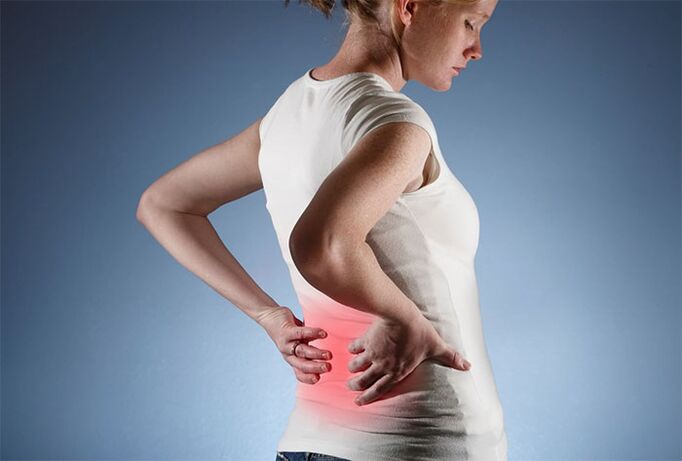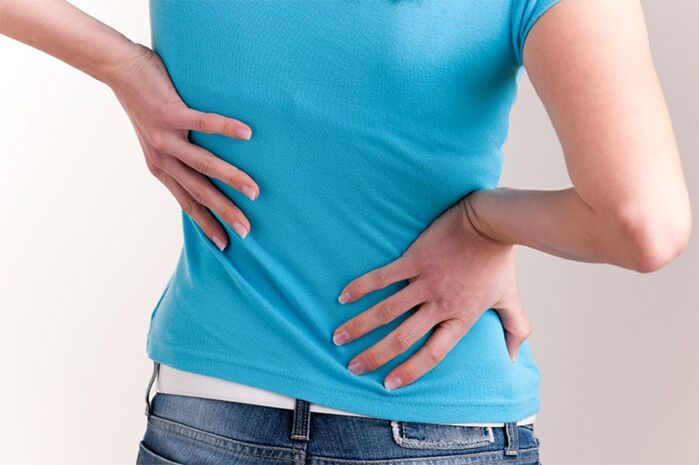Today, back pain is the second most common reason for patients seeking medical help. According to the American National Institutes of Health, every fifth middle-aged person suffers from pain. At the same time, the incidence of the disease only increases with age. In medical practice, pain (dorsalgia) is considered an interdisciplinary pathology, because in the clinic there is a symptom of both neurological and somatic diseases.
At the same time, the incidence of the disease only increases with age. In medical practice, pain (dorsalgia) is considered an interdisciplinary pathology, because in the clinic there is a symptom of both neurological and somatic diseases.
What is the cause of back pain?
Back pain in 90% of cases occurs in spinal diseases (spinal pain). In other cases, the cause can be pathologies of internal organs, spinal cord, etc. (Pain without spine).
Thus, the vertebrogenic group includes:
- intervertebral hernia;
- sacra- or lumbarization; spondylosis; osteoporosis;
- tumor processes of the spine;
- trauma (vertebral fractures, spondylolisthesis).
The nonvertebral group includes:
- psychogenic pain;
- fibromyalgia;
- pathology of internal organs (heart attack, pneumothorax, pancreatitis, urolithiasis, etc. );
- tumor formations (neurinomas) and metastases;
- epidural abscess;
- syringomyelia.
Symptoms
The nature of back pain, its strength and duration vary depending on the underlying pathology.
- Intervertebral hernia.A hernial bulge appears between the vertebrae with the development of osteochondrosis. In this case, the pain may be sharp or painful and may be local in nature (depending on the level of the affected disc). The pain often spreads to the limbs, accompanied by numbness and tingling. In advanced cases (when the hernial sac compresses the nerve roots), disorders of the sensitive and motor sphere of the arms or legs may occur. Injuries to urination, defecation and sexual function (with damage to the pelvic spine) are rare.
- Sacrament or lumbarization.Sacralization is a congenital anomaly associated with the fusion of the last lumbar spine with the cross. In this case, the opposite disadvantage is lumbarization, when the first vertebra of the sacrum separates and becomes an additional lumbar vertebra. Usually the pathologies are asymptomatic, but the clinic is provoked by excessive physical activity or lifting heavy loads. In such cases, there is lumbar pain in the lumbar region, which increases with movement, spreading to the lower extremities. The pathology is also characterized by the fact that it occurs at a young age (usually at the age of 20-25 years).
- Spondylosis.Spondylosis (unlike the previous disease) mainly occurs in the elderly. The disease develops as a result of senile changes in the spine - its "wear". The pathology is accompanied by the growth of bone tissue in the form of osteophytes, which can lead to complete fusion of the vertebrae. The latter is dangerous with injuries to the neurovascular bundles, muscles, and surrounding organs. The disease is accompanied by chronic pain that worsens towards the end of the day. Sometimes the pain syndrome is manifested not only by movements, but also by rest, which leads to insomnia. In uncontrolled disease, there are frequent cases of immobilization of the spinal joints, as well as contraction of nerve fibers with the development of characteristic neurological disorders.
- Osteoporosis.Osteoporosis is a metabolic disorder, during which bone destruction processes predominate over bone formation. The clinical picture of the disease is sparse: the pathological process is usually asymptomatic and is detected by chance (X-ray). However, in the later stages of the disease, dull pains appear, as well as posture curvature.
- Tumor processes of the vertebrae.Spinal tumors are often asymptomatic until they grow large enough to compress nerve fibers. In such cases, chronic back pain (usually in the lower part of the spine) occurs, which can spread to the thighs and lower legs. Sooner or later tumor growth leads to compression of nerve roots, which is manifested by neurological disorders: loss of sensitivity and movement of limbs.
- Injuries.A common cause of acute pain, limited mobility and neurological symptoms are spinal injuries: fractures, bruises, dislocations / subluxations, as well as "slipping" of the spine due to damage to the ligament apparatus - spondylolisthesis. Typically, patients notice sharp diffuse back pain, the presence of bleeding ("bruising"), local swelling, and limited movement.
- Psychogenic pain.A similar view occurs in the background of full health after an emotional outburst or stressful situation. Patients describe pain in different ways, which is limited only by the patient's imagination. Sometimes there is a so-called. "Painful behavior" when people, while maintaining mobility, tend to use auxiliary support: crutches, canes, and even wheelchairs.
- Fibromyalgia.The pain syndrome in fibromyalgia is extremely similar to that in psychogenic pain. At the same time, pain is also caused by stress, climate, and emotional overload. However, an important difference is that pain should be observed for more than three months, accompanied by local tenderness at characteristic sites (occipital muscle binding site, mid-trapezius muscle, etc. ). Also, the diagnosis requires the complete exclusion of all types of somatic diseases.
- Pathologies of internal organs.Back pain can often occur with diseases of various organs of the body. Thus, in heart attack, the pain syndrome is localized behind the sternum, spreading under the shoulder blade and left arm, as well as in the spine. In pneumothorax (accumulation of air under the lung mucosa), there is acute chest pain that radiates to the spine. The complex of symptoms occurs against the background of shortness of breath and cyanosis of the face. In pancreatitis (inflammation of the pancreas), the pain syndrome has a different character, it occurs in the upper abdomen in the "waist" type, covering the sides and back. Back pain occurs with vomiting and indigestion. The complication of urolithiasis is renal colic - acute paroxysmal pain syndrome. Typically, the pain is so severe that it causes the patient to bend in search of relief. In the background of the attack, the urine becomes dirty red due to impurities in the blood.
- Tumor processes.Neurinoma is a tumor of the nerve sheath. When the roots of the spinal cord are affected, back pain usually occurs, as well as loss of sensitivity and motor activity below the level of the lesion. It is also worth noting that this tumor process is usually benign. However, metastases of breast, prostate, lung, kidney cancer, etc. can cause a similar clinical picture.
- Epidural abscess.An epidural abscess is a collection of pus under the hard lining of the spinal cord. The disease is accompanied by an acute pain syndrome, which is supplemented by neurological disorders: paresis (reduced muscle strength), loss of sensitivity, pelvic disorders, etc. often occur. The purulent process occurs in the background of infections, wounds, immunodeficiency or as a complication of lumbar puncture (or epidural anesthesia).
- Syringomyelia.Syringomyelia is a pathology of the nervous system during which cavities appear in the spinal cord. Diseases provoke injuries, tumors, brain compression, etc. In the initial stages, there is a slight pain in the spine that does not cause discomfort. Then there is weight loss, muscle weakness, loss of sensitivity to pain, no sweating and bones become brittle. There are often injuries to the joints, bone skeleton (burns, fractures, cuts), however, due to the lack of sensitivity to pain, they go unnoticed.
Diagnostics
As a diagnosis, a qualitative examination and physical examination of the patient are required by palpation (palpation), percussion (percussion) and auscultation (listening). For some pathologies, it is necessary to perform laboratory blood tests (heart attack, pancreatitis, tumor processes).

To visualize soft tissues and internal organs, you will need instrumental diagnostic methods: ultrasound or magnetic resonance imaging. While X-ray and computed tomography are used for direct examination of the skeleton.
In some cases, less common techniques may be needed: bone scintigraphy, electromyography, etc.
Treatment of back pain
To relieve acute back pain, apply ice (20 minutes every 4 hours), exclude physical activity, immobilizing the spine if possible. If the pain is unbearable, painkillers can be taken. However, it is worth remembering that anesthetics "lubricate" the disease clinic. This can later complicate the diagnosis of the disease. Only the attending physician can prescribe medication.
Herniated disk
The main drug treatment is based on the use of anti-inflammatory drugs (diclofenac, ibuprofen) and painkillers (ketorolac). In some cases, surgical removal of the intervertebral hernia may be required, as well as endoprosthesis of the intervertebral disc.
Sacra or lumbarization
When pain occurs, anesthetic blockades are prescribed, as well as physiotherapy (paraffin applications, electrophoresis, etc. ). With the ineffectiveness of conservative treatment, reconstructive surgeries are indicated.
Spondylosis
Anti-inflammatory drugs (Meloxicam, Indomethacin) as well as physiotherapy (ultrasound, electrophoresis) are used to eliminate inflammation and pain syndrome.
Osteoporosis
Treatment of osteoporosis begins with a diet high in calcium and vitamin D. Perhaps the naming of these substances in the form of drugs. In some cases, hormone therapy with estrogen, calcitonin and parathyroid hormones is used.
Perhaps the naming of these substances in the form of drugs. In some cases, hormone therapy with estrogen, calcitonin and parathyroid hormones is used.
Tumor processes
Treatment of tumor diseases consists of chemotherapy and surgery. In this case, the amount of help depends on the specific clinical case.
Injury
In case of minor injuries, a gentle regimen and warm-up are prescribed. In some situations, it is necessary to reduce or pull the skeleton. When neurological symptoms appear, operations to fix the bone fragments are performed.
Psychogenic pain
Help with psychogenic pain consists of complex psychotherapy, as well as taking antidepressants (fluoxetine, sertraline).
Fibromyalgia
As the causes of the disease are still unknown, symptomatic therapy is prescribed: antidepressants (Paroxetine, Amitriptyline), anticonvulsants (Pregabalin), hypnotics (Zopiclone) or sedatives (Diazepam). Self-adjustment is also important for positive thinking, avoiding stressful situations and staying in a warm and dry climate.
Pathologies of internal organs
Each of the possible internal pathologies requires individual treatment tactics. A heart attack emergency is taking nitroglycerin (one tablet every 5 minutes until the ambulance arrives); in pancreatitis - colds, hunger and rest; with pneumothorax - sealed (occlusive) bandage in case of open lung wound; with renal colic - antispasmodics (Drotaverine, metamizole sodium) and warming.
Epidural abscess
Treatment consists of emergency surgery to normalize the pressure in the spinal canal and drain the meninges. Antibiotic therapy (Amoxicillin, Cefotaxime) supports surgery.
Syringomyelia
Patients are usually advised to protect their skin from cuts and burns (the latter often occur because patients lose sensitivity and do not feel trauma). Painkillers, antidepressants (fluoxetine) and antipsychotics (chlorpromazine) are also prescribed. In some cases, surgery is possible to revise the formed cavities of the spinal cord.
Prevent Return
To prevent back pain, it is necessary to prevent the occurrence of each of the above pathologies. To do this, you need:

- Normalize lifestyle: reduce body weight to normal; make a proper diet rich in trace elements and vitamins; ensure proper physical activity without overexertion.
- Give up bad habits: smoking and alcohol consumption.
- Correct posture curvature (scoliosis, lordosis) and orthopedic pathology (flat feet, feet, etc. ).
- Diagnose and treat concomitant diseases of the musculoskeletal system or internal organs in a timely manner.
- Prevent or properly treat spinal cord injuries.
- Avoid emotional outbursts and stressful situations.
It is worth remembering that back pain is not an isolated pathology, but a symptom of the disease. The main disease can be extremely serious and, if left untreated, can lead to disability and even death of the patient!































